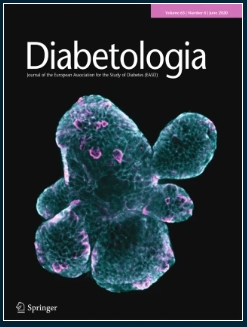Effect of lipotoxic hepatocyte-derived extracellular vesicles in pancreas inflammation: essential role of macrophage TLR4 in beta cell functionality.
IF 8.4
1区 医学
Q1 ENDOCRINOLOGY & METABOLISM
引用次数: 0
Abstract
AIMS/HYPOTHESIS Metabolic dysfunction-associated steatotic liver disease (MASLD) is a common feature of obesity and type 2 diabetes. Under lipotoxic stress, hepatocytes release small extracellular vesicles (sEVs) which act locally and contribute to MASLD progression, but their role in beta cell function and development of type 2 diabetes remains largely unexplored. We aimed to examine whether hepatocyte-derived sEVs (Hep-sEVs) under lipotoxic conditions impact on liver and pancreas inflammation and subsequent effects on beta cell function. METHODS Primary mouse hepatocytes and Huh7 human hepatocytes were treated with palmitic acid and Hep-sEVs were purified from the culture medium by differential ultracentrifugation. In vitro and in vivo approaches were used to decipher the role of Hep-sEVs in liver and pancreas inflammation and beta cell dysfunction in mouse and human pancreatic islets. The contribution of the Toll-like receptor 4 (TLR4) to Hep-sEV-mediated effects was investigated in pancreatic islets from myeloid-specific TLR4-deficient mice. RESULTS Lipotoxic Hep-sEVs targeted pancreatic islet macrophages and induced TLR4-mediated inflammation. The subsequent inflammatory response downregulated beta cell identity genes and impaired glucose-stimulated insulin secretion in both INS-1 beta cells (p<0.05) and isolated pancreatic islets from mice (p<0.01) and humans (p<0.05). Specific deletion of TLR4 in macrophages protected pancreatic islets against inflammation and the impairment of glucose-stimulated insulin secretion induced by lipotoxic Hep-sEVs. Chronic administration of lipotoxic Hep-sEVs in lean mice induced liver and pancreas inflammation through the recruitment of immune cells. This intervention induced hepatocyte injury and fibrotic damage together with detrimental immunometabolic systemic effects. Insulin resistance in hepatocytes (p<0.01) and a compensatory insulin secretion (p<0.001) that prevented glucose intolerance were also observed in mice treated with lipotoxic Hep-sEVs. CONCLUSIONS/INTERPRETATION This study has provided evidence of liver and pancreas inflammation and beta cell dysfunction induced by lipotoxic Hep-sEVs. Our data also envision TLR4-mediated signalling in islet macrophages as a key mediator of the effects of lipotoxic Hep-sEVs on beta cell function.脂毒性肝细胞源性细胞外囊泡在胰腺炎症中的作用:巨噬细胞TLR4在β细胞功能中的重要作用。
目的/假设代谢功能障碍相关脂肪变性肝病(MASLD)是肥胖和2型糖尿病的共同特征。在脂毒性应激下,肝细胞释放小的细胞外囊泡(sev),其局部作用并促进MASLD的进展,但它们在β细胞功能和2型糖尿病发展中的作用仍未得到充分研究。我们旨在研究脂毒性条件下肝细胞源性sev (hep - sev)是否会影响肝脏和胰腺炎症以及随后对β细胞功能的影响。方法用棕榈酸处理小鼠原代肝细胞和Huh7人肝细胞,用差速超离心从培养基中纯化hep - sev。通过体外和体内方法,我们破译了hep - sev在小鼠和人胰岛的肝脏和胰腺炎症以及β细胞功能障碍中的作用。研究了toll样受体4 (TLR4)在骨髓特异性TLR4缺陷小鼠胰岛中对hep - sev介导作用的贡献。结果毒性hep - sev靶向胰岛巨噬细胞,诱导tlr4介导的炎症。随后的炎症反应下调了β细胞识别基因,并破坏了小鼠(p<0.01)和人(p<0.05)的INS-1 β细胞和离体胰岛中葡萄糖刺激的胰岛素分泌(p<0.05)。巨噬细胞中TLR4的特异性缺失保护胰岛免受脂肪毒性hep - sev诱导的炎症和葡萄糖刺激的胰岛素分泌损伤。脂毒性hep - sev在瘦小鼠体内通过募集免疫细胞诱导肝脏和胰腺炎症。这种干预诱导肝细胞损伤和纤维化损伤,并伴有有害的免疫代谢系统效应。肝细胞胰岛素抵抗(p<0.01)和代偿性胰岛素分泌(p<0.001)也在脂毒性hep - sev处理的小鼠中观察到,以防止葡萄糖耐受不良。结论/解释:这项研究提供了脂毒性hep - sev诱导肝脏和胰腺炎症和β细胞功能障碍的证据。我们的数据还设想tlr4介导的胰岛巨噬细胞信号传导是脂毒性hep - sev对β细胞功能影响的关键介质。
本文章由计算机程序翻译,如有差异,请以英文原文为准。
求助全文
约1分钟内获得全文
求助全文
来源期刊

Diabetologia
医学-内分泌学与代谢
CiteScore
18.10
自引率
2.40%
发文量
193
审稿时长
1 months
期刊介绍:
Diabetologia, the authoritative journal dedicated to diabetes research, holds high visibility through society membership, libraries, and social media. As the official journal of the European Association for the Study of Diabetes, it is ranked in the top quartile of the 2019 JCR Impact Factors in the Endocrinology & Metabolism category. The journal boasts dedicated and expert editorial teams committed to supporting authors throughout the peer review process.
 求助内容:
求助内容: 应助结果提醒方式:
应助结果提醒方式:


